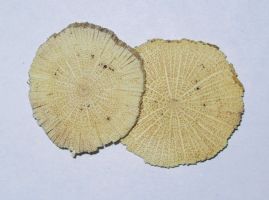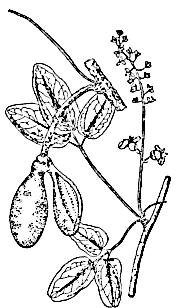- Edema and painful urinary dysfunction
due to Heat in the Heart and Small intestine channels, with
Notopterygium
incisum- Che qian zi.
- Ulcerations of the oral cavity, burning pain in the throat, irritability,
and insomnia due to excess Heart fire. Use with
Lophatherum
gracile- Dan zhu ye and
Rehmannia glutinosa-
Sheng di huang.
- Edema, with
Poria cocos- Fu ling and
Polyporus
umbellatus- Zhu ling.
- Insufficient lactation due to Qi deficiency, with
Astragalus
propinquus- Huang qi and
Angelica polymorpha-
Dang gui.
- Joint pain and obstruction due to Wind Dampness, with
Stephania
tetrandra- Han fang ji and
Atractylodes
lancea- Cang zhu.
- Amennorrhea due to Blood stasis, with
Achyranthes
bidentata- Niu xi and
Carthamus tinctorius-
Hong hua.
- Insuffient lactation, with
Pigs
feet and
Manis pentadactyla- Chuan
shan jia.
[1] Barefoot Doctor's Manual- 1977 Prepared
by the Revolutionary Health Committee of Hunan Province. Original Chinese manual-
Victor W. Sidel. Originally published by Dr Joseph Quin and the Fogarty International
centre, Bethdesda (1974). Madrona Publishers Seattle Washington ISBN 0-914842-52-8
[2] Chinese Herbal Medicine Materia Medica- Dan Bensky and Andrew Gamble- Eastland
Press 1986 Seattle Washington ISBN 0-939616-15-7
Images
1.
oczarjk.pl
2.
tcm.health-info.org
3.
wikipedia.org
User:Chrishibbard7
4.
[1]
Akebin, hederagenin, oleanolic acid, aristolochic acid, oleanolic acid, hederagenin,
calcium.
References
[1] Chinese Herbal Medicine Materia Medica- Dan Bensky and Andrew Gamble- Eastland
Press 1986 Seattle Washington ISBN 0-939616-15-7
 Akebia trifoliata. Akebia trifoliata var. australis 白
木 通
Bái mù tōng Trifoliate akebia
Family: Lardizabalaceae
Akebia trifoliata. Akebia trifoliata var. australis 白
木 通
Bái mù tōng Trifoliate akebia
Family: Lardizabalaceae

 HABITAT:
Grows beneath forests or semi-shady and damp places in thickets.
HABITAT:
Grows beneath forests or semi-shady and damp places in thickets.